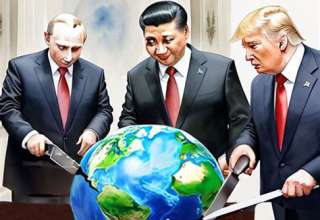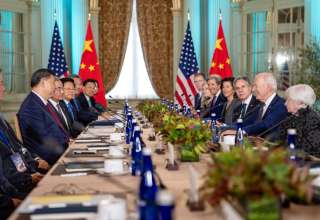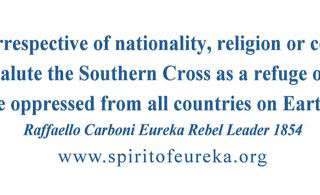By Brian Boyd
Other power blocs
The European Union countries (E U) have tried hard in the global economic uncertainty, to protect their respective spheres of influence, internally and externally. Their defence framework is called the ‘European Economic Security Strategy’. The EU has moved to completely end its dependency on Russian gas. It is also trying to fend off the broader economic spill-over, arising from the trade and technological competition between the US and China.
At one point, the imposition of US tariffs forced the EU into “submission”. It had to agree to invest $US 600 billion in America and purchase $US 750 billion of US energy. One newspaper headline stated: ‘Trump humiliates featherweight European Union’ (The Telegraph, London 29 July 2025).
It was pointed out that fifteen years earlier the E U “had an economy that was slightly bigger than America’s”. This was compared with in 2025 when it became 25 percent smaller.
European Commission President Ursula von der Leyen said its tariff deal was “the best we could get”.
Also E U Stock Exchange listing volumes have become moribund, and are shrinking. E U leaders are seeing the withering of these historic exchanges “as an emergency”, with the key culprit been described as the widening wealth gap between Europeans and Americans. Further, European politicians openly acknowledge that America’s domination over financial markets “reduces Europe’s strategic autonomy”.
Russia, with its oligarchy, crony-based brand of capitalism, is in a heightened level of challenges to its evolving sphere of influence. This is especially so, given the global opposition to its “hot war” in Ukraine and its various levels of interference in other countries.
With Japan, post the US tariff impositions, its government agreed at the “discretion” of the US president, it would invest $US 550 billion into America! Post Brexit, Britain ran with the ambitious policy slogan –‘Global Britain’. Fast forward to the first half of 2025 and the British economy was shrinking and struggling to bounce back from the imposition of US tariffs. Listings on the London stock exchange has fallen by over twenty percent in just five years.
Other countries entertain forging groupings of developing nations e.g. B R I C S, in an attempt to protect their economies from the overarching weaponisation of trade and commerce by the bigger power blocs.
Hot Spots
Conflicting great power ‘spheres of influence’ generate particular flash points.
The US talks about seizing Greenland and the Panama Canal and even absorbing Canada as a 51st state.
There are border clashes involving India and Pakistan and Thailand and Cambodia.
The South China Sea continues to be a never ending ‘hot spot’.
Melting ice caps in the Artic region see various powers developing bases and competing trade routes.
The Middle East continues to generate ongoing conflict, with most of the great powers all having input.
India has indicated it too, wants to become one the world’s most advanced economies. Using familiar language it has advanced its own slogan: “Make India Great Again (M I G A)”.
Endless clashes on the African continent also involve much great power influence and interference.
And of course the war in Ukraine absorbs much time and shadowboxing by the great powers. Ukraine is but a pawn, with the US, Russia and the EU scrambling to see whose sphere of influence will hold sway. The US has made no secret Ukraine is an E U problem first and foremost, stating: “it is in your neck of the woods”.
In a world undergoing profound shifts towards multi-polarity the interplay involving the economic, geopolitical interests of global powers, with their persistent regional conflicts, needs to be put in perspective.
Inevitably the ambitions of major powers such as the US, China, EU and Russia, underscore the depth of their rivalry and the impact on international stability.
We are witnessing today not just conventional military conflict but many other forms of so called ‘grey’ competition. The claimed ‘borders’ of spheres of influence are increasingly becoming overlapped, interactive and unpredictable.
The economic essence of this shakedown requires a more aware public.
For regularly, in the media, conservative agents of influence propagate arguments and scenarios promoting wider militarisation and the necessity to go to war.
Politicians of all persuasions in Canberra refuse to brief the public on the details of ‘threats’ to “Australia’s interests”.
Australia’s reality
Australians are told by the current Foreign Minister that the government’s position for our region, is to support a balance of power, “where no country dominates and no country is dominated”. It has been pointed out by some that, in practice, this could be taken as: “… Opposing Chinese domination”, but “also a formulation that opposes US dominance”.
A series of governments in recent years have also proclaimed that we are living in “the most dangerous strategic circumstances since World War II”. No specific evidence of the nature of these threats are ever provided by the politicians.
At the same time, there is a growing acceptance that Australia should adopt a more independent foreign policy and stress the importance of Australian sovereignty.
We are told that our government’s strategy is- “the ultimate objective being to prevent war”, breaking out in our region.
Yet the reality is that hot war between the US and China is demonstrably being calculated in Washington and Beijing, with military build-up‘s being accelerated.
Furthermore there is a publicly acknowledged cohort of so-called security/foreign policy commentators (e.g. Greg Sheridan, Peter Jennings and John Lee), who push, on a regular basis in newspaper columns, that the federal government should simply side with the US and prepare for war with China. Such commentators sneer at any suggestion that Australia is mature enough to have its own national interests defined by self-respect, with a genuine independent, sovereign framework.
By mid – year Australia was informed that the A U K U S agreement of 2021 was under review in Washington and US officials were insisting that Australia was ‘locked-in’ to supporting America in any war with China.
At one point Prime Minister Albanese said misleadingly, at a recent John Curtin oration, that we “never followed the flags of other lands”. This was in response to some in the current U S administration, insisting Australia will again have to follow the US into war.
Some mainstream political commentators were taken aback by the US officials linking Australia’s A U K U S involvement to guaranteeing Australia’s participation in any future conflict, involving the US in our region. Descriptions such as “arrogance and ineptitude”, “a totally unjustified demand”, “shocking” and “a repudiation of Australia as a sovereign democracy”, were used in one article (Australian, Paul Kelly, 16/7/25).
Regardless the Albanese government has made no attempt to resolve the obvious contradiction between Australia’s involvement in A U K U S that, enmeshes Australia further into the US war machine with every passing year, and its rhetoric that the government is standing for sovereign independence.
“If Albanese can be faulted, is the contradiction in celebrating Curtin for standing up to London and Washington when Australian survival was at stake[during World War II], while the Albanese government has continued to erode the same Australian sovereignty by its blind extension of the American military footprint on our continent, which now includes the stationing of nuclear-armed B-52 bombers in the Northern Territory…” (James Curran, A F R, 14/7/25).
Another commentator midyear suggested: “… in Washington eyes, Australia is an aircraft carrier moonlighting as a continent”.








